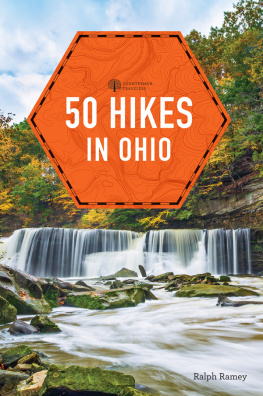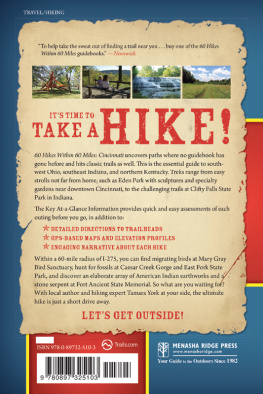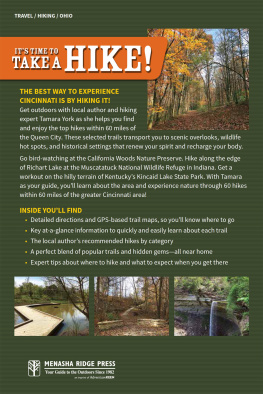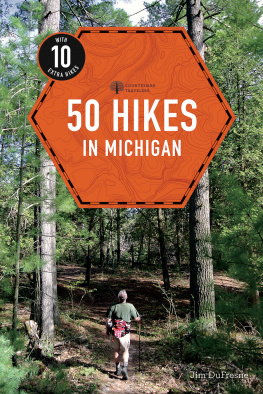


THE COUNTRYMAN PRESS
A division of W. W. Norton & Company
Independent Publishers Since 1923
To my wife, Jean, and sons, John and Jim, without whose writing,
editing, computer skills, and patience I could not have completed
this new edition of 50 Hikes in Ohio .




POMPEYS PILLAR, GLEN HELEN NATURE PRESERVE

CONTENTS
H iking has been an important part of my life since I was in grade school. It was in the fields, woods, and river valleys east of my Bexley home that I developed my love of all things natural; where I first found monarchs sipping the nectar of milkweeds; where I found trilliums, wild blue phlox, and Virginia bluebells, garter snakes, click beetles, and much more. Yearning to be able put names to these, and to the birds I found around my yard, I rode the streetcar to downtown Columbus and, at McClellands Book Store, began buying the Putnam Field Books of Nature . Boy Scouts and summers at YMCA Camp Willson hardened my desire to spend my life out-of-doors as a naturalist.
The rest is the story of my life: a degree in wildlife conservation from OSU, a hitch in the army where I served as hike master for the Forth Army Chemical Defense School. Back in civilian life, I landed a job as specialist for the Ohio Division of Parks and Recreation. Since then, with a hand lens in my pocket and binoculars over my shoulder, I have explored every corner of the Buckeye State on foot and occasionally by bicycle or canoe. I spent 4 years with regional park districts, 17 years as director of Antioch Colleges wonderful Glen Helen Nature Preserve, and ended my working years as Chief of Ohios Division of Natural Areas and Preserves. I would like to think that many of my readers have been among the groups that accompanied me on my explorations of the land between the river and the lake. If you were, you know that I have a strong penchant for human history and that there wasnt a towpath that I wouldnt hike nor a mound, pioneer graveyard, iron furnace, covered bridge, barn, or dam site that I wouldnt take time to explore. I spent many happy years walking the woods and fields of the Buckeye State with groups of fellow outdoor enthusiasts.
When I began scouting trails for inclusion in my books, I became a devoted solo hiker. My only companion most trips was a microcassette tape recorder. In preparing this edition, I spent many hours listening to these old tapes. Dont get me wrong, I am not recommending hiking alone as a general practice; but I do love it. As with all of lifes actions, you weigh the risks and make your own decision.
No longer able to hike, for this edition I have depended on those tapes, my memories from years of hiking trails throughout Ohio, websites, up-to-date agency literature, and long phone conversations with hiking friends and workers at the sites. There have been many changes to the trails over the more than 25 years I have been writing 50 Hikes bookssome big, many small. First of all, nearly all trails, short and long, now have names. Some, like rim or lakeside, are descriptive. Others, such as red and blue, dont describe the trail but simply tell you what color paint blaze to look for. Effort has been made to include such name changes; however, undoubtedly some have been missed or even changed very recently. In a number of cases the managing agency or the name of the area where the hike is located have changed. New bridges and steps have been built. New visitor centers and nature centers have arisen and in at least three cases, locations of parking areas have changed. But the years have enhanced the natural beauty to behold, and outdoor Ohio is as gorgeous as ever. I also believe that the stewardship of the resources by public and private organizations is better than ever.

A HEAD WATER STREAM, DYSART WOODS
T hough Ohio ranks 36th in size among the 50 states, it is 7th in population. A major agricultural state, it is also heavily industrialized, with most of its 11 million people living in one of six urban areas. Shortly after World War I, civic leaders recognized a need for large, publicly owned natural places for outdoor recreation near the cities. Thus was born the states system of local park districts, one of the nations finest. There are now metropolitan park systems in all of Ohios urban areas and in many rural counties as well. Most operate on a philosophy that calls for retaining 80 percent of the land in a natural state. They have many miles of trails and are great places to hike. This book includes a selection of hikes in parks with especially nice natural features from several districts.
In 1918, Ohio began to systematically acquire state forest land. Though originally established to preserve (or perhaps restore) the timber resources of the state, the 173,415-acre system now includes an area designated as wilderness where no timber-management activities occur.
The federally operated Civilian Conservation Corps (CCC) of the 1930s built many recreation facilities, including trails in the state forests, and many of these still provide great pleasure to hikers. New trails, including two backpacking trails, have been added in recent years.
In 1949, a unified Ohio Department of Natural Resources (ODNR) was created, establishing for the first time a state park system. Publicly owned lands that were being used as parks or that had the potential to be developed into parks were put under the control of the ODNR, and they became the nucleus for the present 200,884-acre state park system. Nineteenth-century canal feeder lakes, scenic areas of state forests, and lakes created for fishing, flood control, stream-flow augmentation, or water supply were among the diverse areas brought into the system. As major flood-control projects were built in the 1950s and 1960s, they joined the fledgling park system. Today, virtually all of the 72 state parks have some foot trails.
A direct descendant of the earlier Division of Conservation and Natural Resources of the Department of Agriculture, the Division of Wildlife manages areas large and small across the state that provide places for the public to hunt and fish. Though paid for with fees and taxes collected from sportsmen, state wildlife areas are now being managed for overall biological diversity as well as for fish and game production. Some offer good opportunities for hiking, and two such areas have been included in this book, although hikers will want to explore these areas outside hunting season. A complete list can be obtained from the ODNR.
Next page














